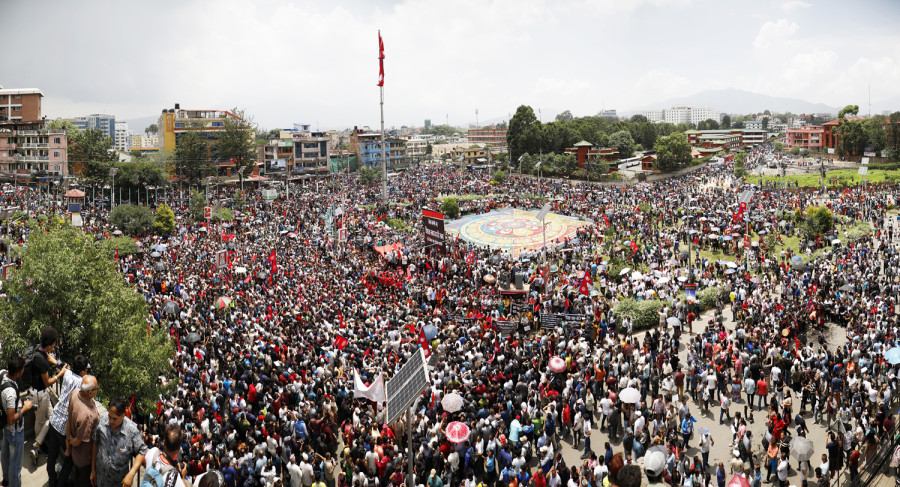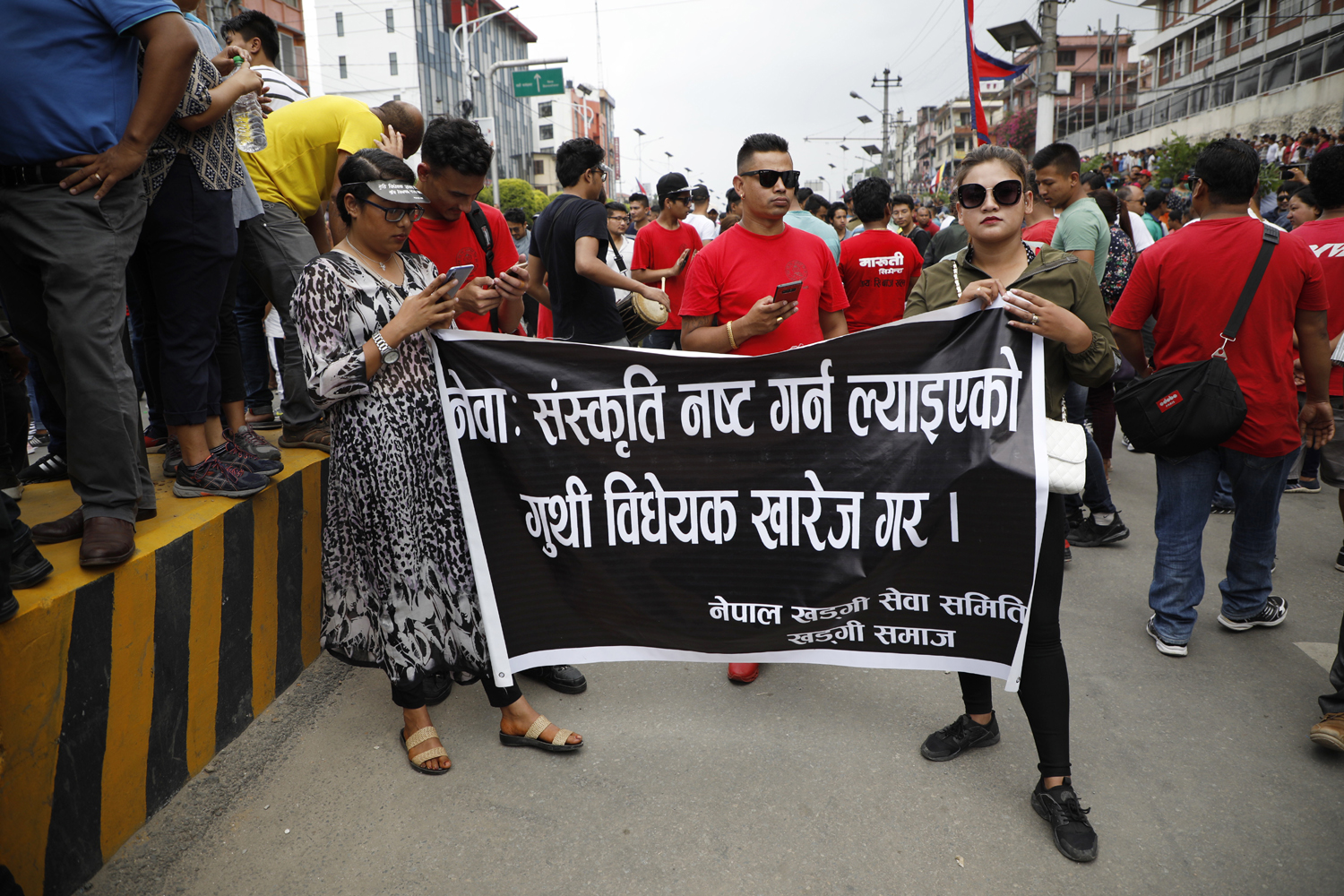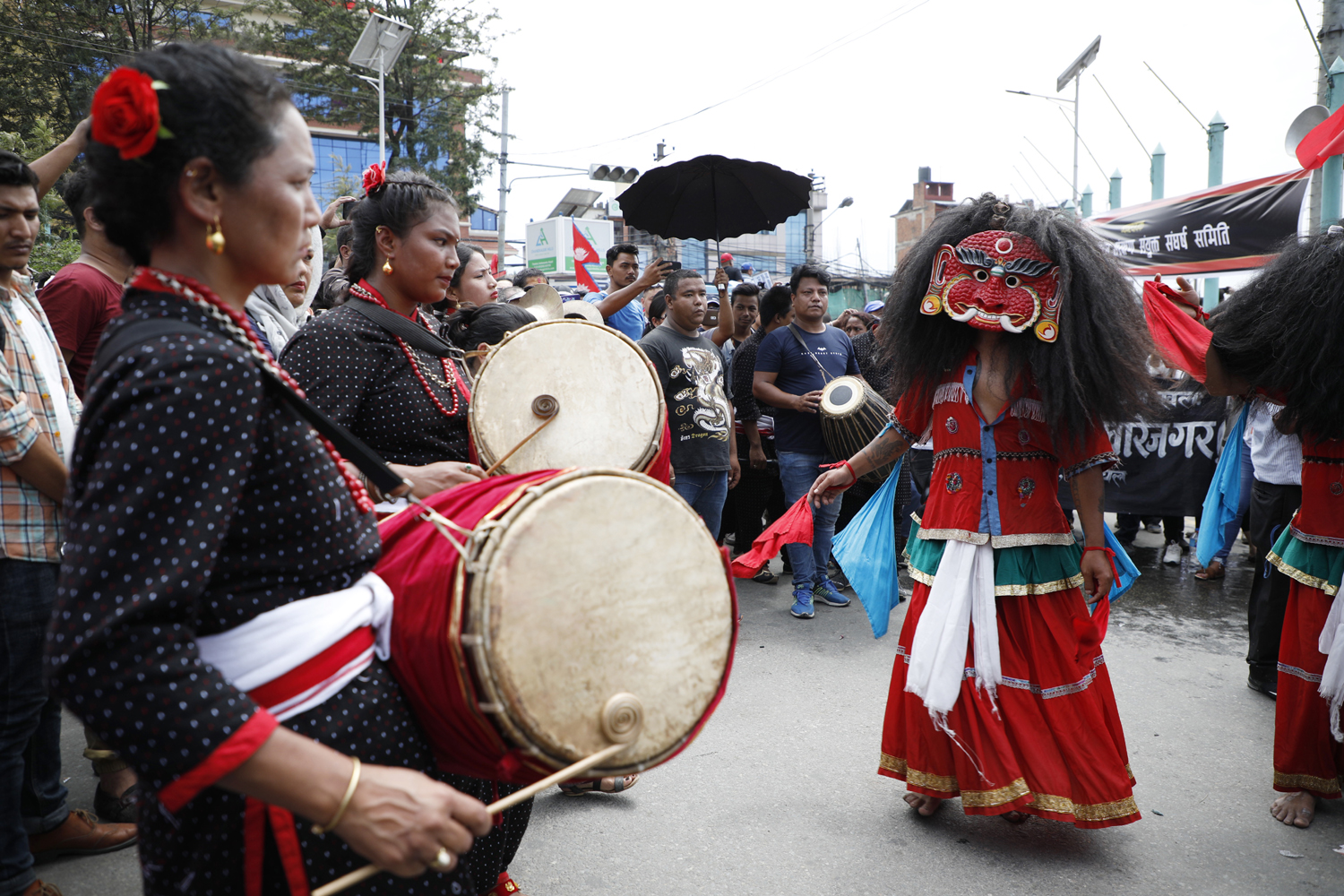Valley
In biggest protest since the 2006 People’s Movement, thousands of protesters gather to oppose the Guthi Bill
Although the government had withdrawn the bill from the National Assembly on Tuesday, protesters demanded that the bill be scrapped completely.
Anup Ojha
On Wednesday, Maitighar Mandala was a sea of people. In what was possibly the largest apolitical mass protest since the 2006 People’s Movement, thousands of people arrayed the streets around Maitighar, colourfully attired, some wearing headbands, others carrying placards, banners and the national flag—all protesting the controversial Guthi Bill.
Despite the government’s withdrawal of the bill from the National Assembly on Tuesday, residents of the Kathmandu Valley—mostly Newars—took to the streets in large numbers, protesting what they called a state-led attempt to wipe out centuries-old customs and traditions. The protesters demanded that the bill be scrapped completely, not just amended.
The rousing sight of the massive turnout had been building for some time now, with a protest on June 10 suppressed with water cannons and batons. This time, with thousands on the streets, police refrained from using force.

“Eleven days ago, when we protested, the government thrashed us with batons and used water cannon to disperse us. Many of us were injured. Now, the whole city has woken up to fight to preserve our culture and protest the government’s autocracy,” said Ganapati Lal Shrestha, coordinator of the Rastriya Pahichan Samukta Sangharsha Samiti (Joint Struggle Committee for the Preservation of National Identity), who has been protesting the Guthi Bill ever since it was tabled at the National Assembly on April 29.
Since then, criticism has erupted in the public sphere, with various opinion pieces in the media arguing against the proposed bill and cultural activists like Shrestha holding rallies and mass meetings.
Resentment had built to boiling point while Prime Minister KP Sharma Oli was in Europe for a week. When Oli returned, a meeting with party members from the Valley had warned of serious consequences if the bill wasn’t withdrawn and Valley residents took to the streets in force. A day later, in a hastily arranged press conference, Minister for Land Management, Cooperatives and Poverty Alleviation Padma Kumari Aryal announced the withdrawal of the bill, with the prime minister’s support.

“Today’s mass came to the streets because the government attacked centuries-old beliefs,” said Alok Siddhi Tuladhar, a cultural activist and a leader of the Save Heritage Campaign.
The bill was an attempt by the government to take ownership of the guthi—traditional community trusts—when the real owners are Newars, said Tuladhar.
As if to refute Prime Minister Oli’s disdain for those critical of the Guthi Bill, Wednesday’s protest included people from a wide-range of ethnicities and backgrounds, all of whom came together to defend culture against what has widely been seen as an attempt to privatise and sell off guthi-held lands and properties.

Among the protestors was Jahid Shah, a representative of the Jame Masjid. Shah, a Muslim, had closed down his stationery shop in Putalisadak to join the protest.
“We also have our own guthi lands and we want to preserve our ownership,” said Shah.
There are some 2,335 public guthis under the Guthi Sansthan, incorporating 1.4 million ropanis of land across the country. These guthis, while largely managed by the Newars in Kathmandu Valley, also encompass the trusts of various other religions and traditions.

For such a large protest, the mood was festive and celebratory, as musicians pounded out beats on the Dhimey and masked dancers paraded in between the crowds, showcasing the various artistic and cultural pursuits the guthis sustain. Guthis are primarily responsible for all of the Valley’s most prominent processions, including the Bunga Dyah Jatra (Rato Machhindranath Jatra), Jana Baha Dyah Jatra (Seto Machhindranath Jatra), and Yanya Punhi (Indra Jatra). Community members were also seen handing out water to protestors and riot police alike, giving away flowers, and cleaning up after the protests.
However, simmering anger at the government’s controversial bill—one among a slew of others, including the Media Council Bill, Information Technology Bill, and transitional justice bill—was palpable.
“Today, we saw the rage of Newars because the government, instead of helping to preserve their culture, attacked their traditions,” said Manuka Dangol, who came from Kapan to show solidarity with the protest.
Some colleges had even declared a holiday for their students so that they could take part in the protest, with IME College in Thapathali bringing along its students to Maitighar Mandala.
“Kathmandu Valley is known for Newa culture, which has been preserved for years,” said Sonam Singh Dhami, a student who had gathered at the mandala with his friends. “We could not continue with our studies while our culture was being attacked. That’s why we are here today.”




 15.69°C Kathmandu
15.69°C Kathmandu.jpg)











